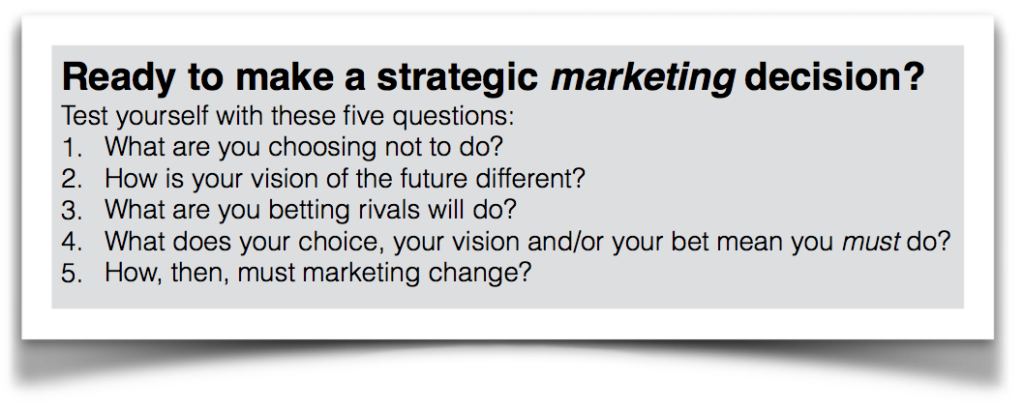|
Category: Marketing Stats
June 27th, 2018

We are big believers in Moore’s Markets Adoption Theory (famously known as Crossing the Chasm) here at Mortar. (In fact, it’s so bad my colleagues think I should tattoo it on somewhere on my body).
Many of you are probably already using Moore’s thinking, but for the uninitiated, allow me to present THE SINGLE GREATEST MODEL FOR LAUNCHING A NEW IDEA. ANY NEW IDEA. There. I don’t think that is overdoing it all.
Moore’s model is not the first to describe the path innovation takes from whimsy to mainstream. But it is one of the best. And the popularity of the model makes for easy meetings with innovators and those who love them.
Now, if you asked a hundred people if you were crazy, and only one said yes, would you believe them?
Moore says maybe you should.
For Moore the early market is a special place. It’s populated by those on the fringe. People who care about features others ignore. In many ways, Disaster Preppers are in the early market for the apocalypse. Likewise, Flat-Earthers never crossed the chasm to join the rest of the world in believing the world is round (wait, what?).
But not every member of the early market is crazy. Some of the most passionate early adopters can be found in august institutions like Johns Hopkins, the Mayo Clinic, Stanford, UCSF Medical Center as well as mainstream giants like VMware, IBM and Cisco. And they can be found in every start-up. (Although, beware, not every start-up employee is a visionary… more on that in a second).
The first buyers of new ideas are often visionary in character, attracted by revolutionary change, and largely comfortable with half-baked features that others regard as untested or unfinished.
But these pioneers are also prone to be needy, goal obsessed, and keen to brag. Especially about being the first on the block to grab innovation by the horns and wrestle it into submission.
And, because they are obsessed with the new and promising, they will also be among the first to quit. Visionaries like to jump onto the next big thing. And that can be a problem. The early market is a dynamic, fickle force which can be hard to tame and even harder to keep caged.

Source: Wikipedia
Here are five things about the early market most overlook:
- The early market is always in the minority. i.e. It will be small. So if you talk to 100 people about your new product, less than two may say it’s awesome. 98% will tell you it sucks. And a 98% rejection rate is hardly compelling evidence that you’re onto something. And yet, that is exactly what you can expect in early market testing.
- People who sell to the early market are rarely comfortable selling to early adopters. Your team, those stalwarts who have chosen to join you on the front line of change, they too are surrounded by doubters and skeptics. So is your Board. And your investors. Everyone wants guarantees. Or at least promises. They will all push you to go for the money. Now. And the money lies in the fattest part of the bell curve with the elusive majority. So why aren’t you selling there now? Moore urges caution and the need to establish a beachhead first. But to do that is to sit back while someone else exploits the fat found in the middle of the herd! To win with early adopters is to focus on them and them alone: and that is often a counter-intuitive move. Savvy early marketers limit discussion to early market needs, focus research on early desires, and largely ignore what the rest of the market has to say. Don’t make the mistake of testing early ideas with the majority as the results are unlikely to be helpful.
- The early market is very different from the late market. To find where you are on the curve, it’s important to understand the differences between the two groups. Somewhere in your product’s journey to success is a gap. This “chasm” lies between the radicalized, crazy, fanatical first customers and their more prudent, careful, and risk-averse brethren. Put simply, pragmatists don’t trust visionaries. Pragmatists think visionaries are crazy. And pragmatists bore visionaries with their endless prattling about avoiding risk and loading up with check-box features that few want. Yet, significant numbers of pragmatists have to be swayed by visionaries for an idea to root and blossom. There is a gap between the two groups: and most new ideas fail trying to bridge the yawning chasm between pioneer and pragmatist.
- The traffic moves in one direction: from left to right, early to late. Ideas move from new to old. They are birthed. They grow. Mature. And eventually pass into the mainstream. And after a while they wither and die. The point here is that they rarely pass from mature to death and back to sexy again (note I said rarely: fashion is well known for resurrecting dead ideas, which partially explains why my teens are crazy about bell-bottoms). It is hard for a new idea to retrace its steps, especially when the gloss has worn off. One is reminded of the old saw “you never get a second chance to make a first impression.” If you are stewarding a new idea across the chasm, you will do well to avoid jumping too early.
- Your industry is not any different. Don’t fight the theory, embrace it. We (by which we mean the smart people and, yes, Mortar) have been teaching diffusion theory since Rogers first published Diffusion of Innovations in 1962 (check this out). It’s hardly a new idea or a novel expression of market development. The principles are tried and tested. Sure you can break into a market by penetrating the middle: but it takes a lot of effort and cash. That’s why so many Super Bowl advertisers are major, established brands — Coke, Pepsi, Jeep, Bud — and why so few companies trust debuting a novel idea in a $3 million commercial (although there is a stand out or two every year). Still, if you are launching an idea outside the mainstream, you can gain a significant advantage by embracing the lessons of market adoption theory and watching your own customers for the telling signs of quivering, flighty pioneerdom. Or you send me an email and we’ll do it for you.
* This article has been updated from our original publication: “The Joys of Selling to the Early Market” here.
October 2nd, 2016

More Mortar clients are complaining about selling to Millennials. And that got me wondering: what do the pundits have to offer on how to approach today’s Millennial?
Unlike previous generations, Millennials grew up with the promise of instant and frictionless access to information and one another. As a result, they are more likely to think differently about what it means to “own” something. Writing in Fast Company, Josh Allan Dykstra writes that “this new attitude toward ownership is occurring everywhere, and once we recognize this change, we can leverage it. Instead of kicking against the wave (which is the tendency of many institutions and leaders), we can help our organizations thrive in this strange new marketplace by going with the flow and embracing the death of ownership”.
Look, Dykstra emphasizes, ownership just isn’t hard anymore: “We can now find and own practically anything we want, at any time. Because of this, the balance between supply and demand has been altered, and the value has shifted”.
We know the experience of acquisition matters a lot to us now, and this is especially true of Millennials: How we find out about and buy a product can be as important as what we actually do with it. For example, just consider how much time the modern marketing suite now spends in user experience discussions. Indeed for some eco-conscious customers what we do after we own a product can also be pivotal (like how do we dispose of all that ugly packaging that comes with every Amazon delivery?).
Facebook reminds us that experience is additionally powerful because of how it connects us to others. Our purchases have greater impact because we can perhaps do something worthwhile, tell others about it, and have it say something meaningful about us and our motivations.
Our newest customers, then, approach ownership differently, encourage us to think beyond purchase through to the act of use, and what the conversation might be around our product and the experience we provide.
Here are five of the more obvious ways Millennials buy differently—along with some tips on what Marketers might be able to do to take advantage of the change:
1. Millennials are more likely to buy things because of what it says about them.
The product or service we deliver can help people do something significant that goes beyond actual use. Method, Seventh Generation, ZipCar, Southwest Airlines have all built brands around a superior and differentiated view of what their customer wants. Action: Make sure you tell your customers what their purchase actually says about them: look for ways to connect your product to something they will find meaningful and compelling. Mortar’s repositioning of Fair Trade USA leveraged this insight with “Every Purchase Matters” tagline.
2. Millennials buy things because of what they can tell others about it.
Of course there’s a social piece to owning something that is ever more vibrant. The joy isn’t all in the having it is in the sharing. When we share something we like with others we create a bond that is meaningful—and “the goodwill created in that moment expands to encompass our brand and our business in general”. Action: Start to think of your employees, their families, your customers, commentators, prospects and maybe even rivals, as a community of like-minded people coming together to achieve something new and important. Tell prospects more about what their purchase could say about their work and their position in the community. Give your community more opportunities to share the news of their finds. And be responsive to feedback. Witness Mortar’s client Chef Software leverages community to spread the power of increased automation in IT..
3. Millennials are more apparent about their values.
Millennials are very open about how their values shape behavior. As Dykstra indicates this maybe “explains why so many Millennials are moving to Urban areas. Although it is tempting to see the return to the cities as anti-car, instead, it could be more about all the other things a “non-car life” represents: it helps Millennials be more environmentally conscious, socially aware, and local. This distinction of purpose may seem nuanced, but motivation is a powerful differentiator (perhaps one of the most powerful)”. Action: Understand the values that drive your audience. Connect people to something bigger than themselves through your product or service. Our work for San Francisco’s famed Exploratorium museum is obviously designed to help its community enjoy learning about their environment with a special emphasis on science, but not so clear–but nevertheless critical–is the hidden appeal to building an informed citizenry through increased engagement.
4. Millennials hate to wait.
We all hate to wait. But Millennials have grown up in an age of abundant choice and easy switching. Waiting for them is not just a chore it is an offense and an indication you just don’t care. Action: Take a look at how you engage with your customers and prospects and implement new tools that will enable you to message customers when they are on your website, respond in real-time to questions. Be flexible and authentic with your responses. Wired indicates that more than 50% of customers will abandon their cart on the spot if they can’t get a question answered immediately.
5. Millennials love to shop on their smartphone.
Mobile is the platform of choice for most of us, and this is certainly true of Millennials. Indeed, pundits point out that Millennials just aren’t using their desktop computers as much. And they are not alone: how many of us grasp our iPhone’s like our lives depend on them? Action: make sure your mobile experience is awesome.
As Toffler warned in Future Shock, technology disruption happens fast—but it takes society a long time to catch up and adjust to changes in behavior. Amidst all the concern about selling to young buyers lurks an incredible opportunity to differentiate and grow. Don’t be one of those leaders who thinks they can thrive by ignoring the fastest growing part of their market
September 10th, 2016
 First whiteboard: the Cross-Cloud era lives. Palo Alto April 22, 2016. Strategic Marketing Decisions (SMDs) don’t come any bigger than last week’s announcement of VMware’s new cross-cloud architecture (which we helped create). With cross-cloud VMware is betting there is more money to made in catering to business’ need to consume different clouds than there is in building and marketing its own cloud.Here’s just some of what this, the single biggest decision about cloud since, well, the beginning of cloud (*celestial trumpets blare*), could mean for marketers like us:
Cross-cloud is a massive new playground for innovation and delight.
There are already a lot of clouds. Microsoft, Amazon and Google are the public clouds we know. But others also offer clouds: Joyent, Ninefold, Rackspace. Thousands more flavors are sure to follow. We must now shift from thinking of cloud as something offered by a small number of massive vendors to how we will surf across multiple environments custom-built for us by smaller, nimbler, more specialized providers. And VMware is the first of many trusted guides.
Existing notions of hybrid cloud (public/private cloud) too will need to expand to allow for workloads that span the data center and multiple public clouds. With these new options, business gets the ability to draw on the power of infinitely dedicated resources when the need arises, without being limited by the capability and practices of one vendor. Which in turn means we can shift from marketing cloud as a good thing for service delivery and lower costs, to waking up to the possibilities that the cloud is an infinite canvas for innovation and progress.
Cross-cloud is another reminder the future will be open.
That cross-cloud is happening was not hard to predict. Technology is an irresistible disruptor and innovation abhors limit. AWS, for all its glory–and make no doubt about it, the rise of Amazon’s cloud is an epic success–is still a closed environment. AWS does not have an incentive to encourage other clouds. VMware’s cross-cloud move is one more indicator that the long-term future of technology will be open. And that whenever we are tempted to throw up walls around progress–all we do is tempt others to knock them down.
Cross-cloud means we can drop the from “cloud”.
For a decade now we have been figuring out how to talk about “cloud”. Now the singular is forever “clouds” plural we can drop the “the” and talk about the move to cloud without upsetting our grammar coaches. But we had better get a move on as ubiquity will soon give rise to irrelevance. After all, besides technologists talking to technologists do consumers really care how we get them services? They care more about what we get to them–and what they can do with their new powers.
Cross-cloud means faster, cheaper, better marketing experiences.
With diversity comes choice, competition, and the need for portability. Technically there is no such thing as a cross-cloud application just yet. Yet. The pundits say it is too tough. Mind you, several other Mortar clients have already made cross-cloud moves: With Habitat Chef have figured out how configuration can travel with apps across metal, on and off premises. Netskope offer protection against bad elements hidden in the cloud. And Cycle Computing has baked a model around making sense of out-of-control cloud pricing. His company, Cycle’s Rick Friedman says, enables organizations “to be cross-cloud by managing the mess behind the curtain“.
And now one of the largest software companies in the world, VMware, have focused their entire strategy on the cross-cloud promise. As VMware CEO Pat Gelsinger said after VMworld: “VMware in the past has been about hardware freedom. VMware of the future will be about cloud freedom.” (Parent Dell followed suite by filing for multiple cross-cloud trademarks).
For marketers, this is a reminder of our expanded ability to deliver richer digital experiences. Too much digital marketing remains focused on rudely interrupting people versus, say, giving them the opportunity to download an experience to their device. (For an example watch how Instagram now offers users the opportunity to download an app right from their feed). A wider range of specialized clouds opens the door to faster, more engaging, more personal delivery of digital brand extensions. In the cross-cloud era, choice and competition ride long with lower prices and improved delivery options.
In the cross-cloud era imagination will increasingly take point.
The big A-ha here is that cross-cloud is where the puck is going to be. The cloud is only ten years old, and already we are talking about more cloud, bigger apps, greater velocity, ever grander innovation and scale. It is no surprise technology is headed to the cloud. What is surprising is that the world is only just now waking up to the promise of engineering across multiple clouds. For a long time now advances in marketing have been wedded to developments in engineering (think cookies, CRM, Facebook, the conversation about agile). Where engineering goes, we tend to follow. Only maybe this time we can take point?
The cross-cloud era has arrived folks. We’re thrilled to have played some role in the birth of the world’s foremost cross-cloud pioneer. Perhaps we can help you make sense of it too?
July 30th, 2016

Since 2002 Mortar has been a big idea agency. But no more. We have decided to change.
Read on for why you might want to join us.
Until this year we believed the essential elements of a project should be condensed onto a single page. Each of the briefs we developed were organized around a bold and inspiring big idea.
The big idea was Mortar’s launching pad for iteration and creative thinking. (Read more here).
In 2016, we replaced the big idea with two steps: a strategic marketing decision (SMD) and an A-ha moment. This article deals with the SMD, I’ll publish on the A-ha soon.
Instead of arguing to a big idea we make a big decision about how to market. To decide what we will do differently this time. To articulate how the message should change because the way we see the world—and the client’s customer community—has also shifted.
Introducing Strategic Marketing Decisions
We call them strategic marketing decisions (SMD). Making one can be a lot harder than it sounds.
For example, let’s take the problem that plagues Yahoo: is the massive internet property a media or a software company?
If it is a media company, then content production and delivery should be its priority. Hiring Katie Couric, buying Tumblr, paying big money to stream the NFL, these are all moves in the right direction. And they contribute to Yahoo’s unique value.
But what about engineering new forms of engagement?
Take say, Pokemon Go’s innovative use of augmented reality (AR). Pokemon Go is a game. It is an app. But it is also an engineering marvel. By smart use of AR, geolocation, and a sprinkling of inspired game theory, Go’s engineering team created a new form of participatory entertainment.
You just don’t get that type of engineering from a media company, you have to be all in on being a software company.
To walk through one door is to decide not to walk through another. In marketing it is never wise to be all things to all people. Effective marketing requires focus. Focus requires choices and decisions. Many argue that Yahoo failed to prosper because it failed to decide one way or another: and the lack of clarity sapped the company of vital energy, spurring multiple failed investments and inexplicable changes in direction.
What makes a decision a Strategic Marketing Decision?
The BBC defines strategic decisions as “long term, complex decisions made by senior management. These decisions will affect the entire direction of the firm”.
At Mortar, Strategic Marketing Decisions, are decisions that impact the direction of, well, marketing. But they need not be long-term. Just clear and wide-ranging. Like deciding to act like a leader. Or to line up behind a new vision. Or to take a position quite unlike a rival. SMDs are decisions, about marketing, that have important implications.
Writing for the Harvard Business Review Phil Rosenzweig in “What makes strategic decisions different?” describes the basic types of decision. Here’s how they apply to the SMD:

1. Choice
Making a choice can be a strategic move. Many an organization is plagued by its inability to choose—and thus find its focus. Just by clarifying the need for a decision we can often find a new way forward.
Take Vancouver-based Westport Innovations as a example. When Westport came to Mortar they described themselves as “a Canadian IP company”. We very nearly hung up. But after visiting them we realized Westport was, more than anything else, a natural gas engine company. Oh sure they did a host of other things—like make small engine parts and work with other forms of fuel like Hydrogen—but the heart of engine maker thumped at Westport’s core. By making the strategic marketing choice to focus messaging around natural gas engines they could turbocharge the way they talked about themselves and their mission.
2. Inspirational Vision.
“In so much of life, we use our energy and talents to make things happen. Imagine that the task at hand is to determine how long we will need to complete a project. That’s a judgment we can control; indeed, it’s up to us to get the project done. Here, positive thinking matters. By believing we can do well, perhaps even holding a level of confidence that is by some definitions a bit excessive, we can often improve performance.” (Rosenzweig).
In marketing, a decision to make something happen can also be strategic.
By suggesting that a trip to the city of Reno is actually a visit to the Reno/Tahoe area, we remind travelers to the big blue lake that the joys of the bacon-wrapped cheese log of vacations is just minutes away. An example of positive thinking influencing outcomes if ever there was one.
Planting a flag on the hill as a symbol for all to follow can be an inspiring move, and work to spur creativity.
3. Betting.
“The best decisions must anticipate the moves of rivals. That’s the essence of strategic thinking, which [we can] define as “the art of outdoing an adversary, knowing that the adversary is trying to do the same to you.” (Rosenzweig).
Deciding which way the game will go can also be a candidate for a strategic decision about marketing.
A lot of what we decide is based on what we think a rival will do. Strategic decisions based on reading a rival’s tea leaves are wonderful raw material for marketing.
In marketing, deciding to decide can make the difference between success and failure. Watch for my next post: the A-ha moment that follows from the SMD.
October 29th, 2010
Let us speak of awesome things….and things that are Double Awesome.
Crocodile hijacks plane?

Awesome!
Article about crocodile hijacking plane that reads like it may have been written by the crocodile?
 
Double Awesome!
You get the idea.
So.
Writeup in SFThrillist about fun stuff to do in Reno where each picture is a little bit misaligned which makes it seem like you can rent fully-automatic weapons at local eateries?

Awesome.
Using The Power Of Mortar to reverse Reno’s 13-year decline in visitors, room rates and tax revenues?

Double! Awesome!
The Part Where We Use Numbers To Back Up All That Big Talk:
In first 3 months of Mortar’s “Far From Expected” campaign,
- The average daily rate paid for a room in Reno Tahoe jumped by 5%. (Awesome.)
- Taxes from hotel rooms jumped by 25%.
(Also awesome. You thought we were going to say “Double Awesome” there, but we’re talking about taxes, which carry a natural awesome-deficit, so, sorry, no.)
- Visitors to the area increased by some 82,000 room nights – the first growth in a period of nearly 13 years of decline. (See, now that is Double Awesome.)

Double Awesome. It's what we do.
The Part About The Results:
We could have bumped Reno’s numbers up by just giving stuff away. But that’s what’s been going on for 13 years. People throwing their chips in the air as if to say “Vegas! Sort of!” and then a too-low price on a room. Instead, we went after “a specific subset of SF Bay Area tourists (with) the greatest potential for increased Reno visits.”
People who liked Reno–but had not visited, or had visited once, time long ago.
People who are active on the Internet. People like you.
A recent EMC survey of over 1,000 adults in the San Francisco Bay Area showed the following:
"Awareness is higher, Intent-To-Visit is higher, and people are talking about Reno Tahoe USA more."
Facebook fans jumped over 1,000 within one week after the national Save RENO 911! campaign and over 600 within 3 weeks after the Bay To Breakers promotion. Flickr and YouTube hits are up 30%.

Some call it "a grown man in sheep suit." We call it: Strategy!
Attributes that were used to describe the Reno Tahoe brand are: "fun" "good value" "easy" and "unpretentious.” Which, when you consider they used to say “diesel fumes and heartburn," blows right past awesome and heads straight to Double Awesome-town.
Our point? Great creative is awesome. But when it drives great results?
Make ours a double. Fact.
Illustrations courtesy of the amazingly stupendous Allie "Raptor Face" Brosh, whose blog, Hyperbole And A Half is required reading of the very finest kind. We should all give her money. Right after we get back from Reno.
|












